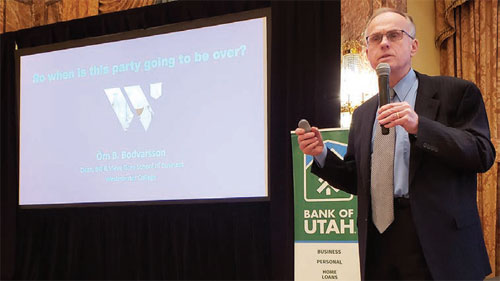By Brice Wallace
Think “Utah” and “party,” and one might logically think “Republican.” But Orn B. Bodvarsson instead concludes “economy.”
The state has been enjoying an economic party — outpacing the U.S. and other states — since the depths of the economic crisis of 2009-10, and Bodvarsson sees reasons to believe the celebration will continue.
“It will be over for Utah when it is over for the nation, but, because we are doing so well with employment growth, I would wager that Utah’s party may last a little longer and not wind down as much,”{mprestriction ids="1,3"} Bodvarsson, economics professor and dean of the Bill and Vieve Gore School of Business at Westminster College, said during the Bank of Utah’s annual economic forecast event in Salt Lake City.
He suggested that Utah’s economic condition mirrors that of the nation’s. “So, if you want to get a sense for the future of Utah’s economy, you need only look at the leading economic index for the United States,” he told the crowd. Any shock the nation’s economy will be felt by Utah’s, he added. “We mustn’t delude ourselves from thinking that we’re immune to outside forces.”
That state/national connection has been in place for several years, despite some people believing Utah is immune from many economic forces, he said.
“I don’t agree with that. We are actually much more dependent on national economic forces than we think. … There’s a higher correlation than we might think between the state and national economies.
“Utah’s economy is far more dependent on the U.S. economy than we think. As the U.S. economy has marched forward, so have we. When the crisis hit the nation in 2009 and ’10, it hit us.”
But Utah has been riding high during the longest economic expansion in U.S. history, which in turn is part of an overall global expansion. Since the depths of the last crisis in 2009-10, U.S. real GDP is up 27 percent, household consumption spending is up nearly 30 percent, and the national unemployment rate is at the lowest point in more than 50 years. Also, hourly pay is up nearly 35 percent and corporate profits have risen over 150 percent. The S&P 500 is up 270 percent since 2010.
Meanwhile, inflation is only 2.3 percent. “We’ve definitely slain the beast of inflation,” said Bodvarsson, who made similar presentations for Bank of Utah in Logan, Ogden and Provo.
But it is all winding down? Bodvarsson said that to keep things in perspective, consider that the U.S. economic growth rate, while decelerating, nonetheless is stronger than it was five years ago.
As for Utah, “we’re actually in pretty darn good shape,” he said, predicting real GDP growth of 3 percent in the state and an unemployment rate of 2.5 percent or so for 2020.
Utah has benefited economically by having a tax- and regulation-friendly environment; a group of industries geared more toward high-growth/leading-edge industries compared with the nation; population growth; a stable, business-friendly political environment; and a perception of being a “destination of choice,” he said.
Still, Utah has economic issues. One is a disparity in economic success. “Not all parts of the state are sharing in the gains,” he said. “In fact, that’s something I’m very concerned about.”
Describing it as “a tale of two Utahs,” Bodvarsson noted that several rural counties have had little job growth and four have actually lost jobs during the state and national expansion.
“That’s very concerning for a state that overall has very high growth rate in employment. Why are the gains not being spread across the counties? What is wrong?”
He acknowledged he had no answer.
“When we have so much county-by-county variation in growth rates, that has the capability of holding us back in our overall growth for the future,” he said.
Another trouble spot is housing prices, but, again, he urged people to keep things in perspective. While Utah’s median housing price is $361,000 and rising — compared with the U.S. median of $280,000 — other Western markets have higher median prices. Portland, for example, comes in at $416,000 and San Jose’s is $1.24 million.
“So we can’t claim that we’re up to California levels. Compared to California, we are still pretty reasonable,” he said. “Really, compared to most of these other cities, really we’re in not bad shape. … So while housing prices are going up in Salt Lake City, let’s put things in perspective. Nationally, we’re still relatively reasonable.
“The test is whether housing prices are creating outmigration. That’s the case in California. My observation is that hasn’t quite happened yet in Utah, but it could, particularly if we get up to sort of Portland levels.”
Bodvarsson’s talk came after a few days of the U.S. stock markets starting taking huge hits because of concerns over the coronavirus.
“Now, some of you may be wondering, just given the last few days, might that expansion be starting to wind down, might it even possibly be over abruptly? … It’s very easy to become a little myopic when you have a run on the stock market and [when] there’s feelings of panic in the global financial markets, it’s easy to get myopic,” he said.
“But we need to think long term and we need to think about the fact that, indeed, we have had a very, very long run and the events of the last few days haven’t changed the long-term trend. You’d have to have many more days of disruptions before [having] a long-term trend.”{/mprestriction}








